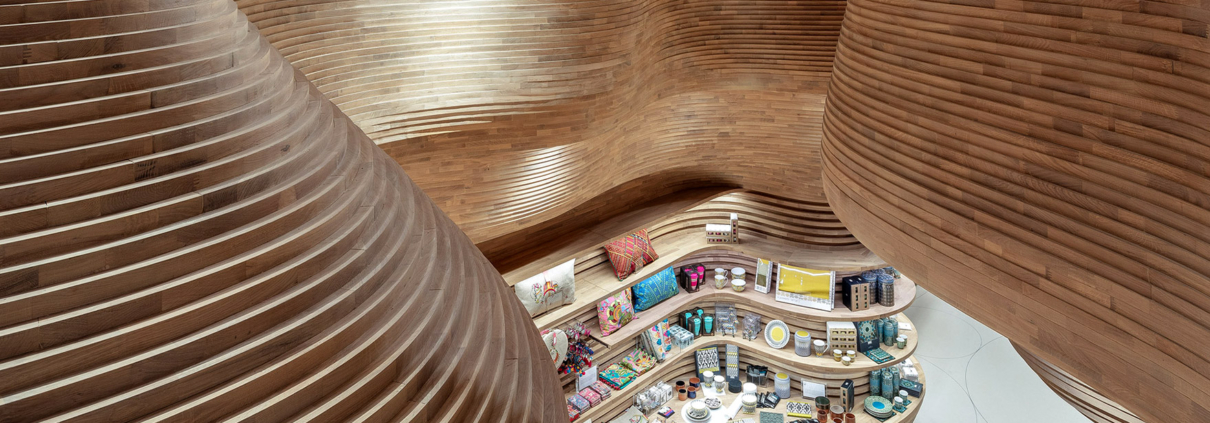Qatar Museum Gift Shops Construction: Find Out How We Made It Possible!
Qatar Museum Gift shops construction: how we managed and handled the wood “movements” of the breathtaking Cave Light in Doha and why we received the coveted Build award in the problem- solving category.
The suggestive Gift Shop and Children’s Gift Shop delivered by Devoto Design for the National Museum of Qatar hide a little “project secret” that we’re going to reveal here for the first time. In the bigger Gift Shop, instead of installing 300 layers of wood pieces as the engineering project had predicted, we only installed 299.
You might wonder how we could have predicted it and how we could have found a solution before we even started the installation on site.. But the question is: how was it possible to construct such a majestic and impressive 10-meter-high wood canyon?
To find it out we need to go back to the engineering step. But before that we remind you that the solutions our team of architects and engineers has provided earned us the prestigious Build Awards 2020.
BUILD AWARDED DEVOTO DESIGN IN THE “PROBLEM SOLVER” CATEGORY
Thanks to our high-end engineering work we have been awarded the prestigious Construction & Engineering “Problem-solver” prize.
Are you ready? Well, let’s go back a few months when everything started..
“Without the craftsmanship and great depth of knowledge on timber works demonstrated by Devoto this would not have been possible”. (Koichi Takada)
QATAR MUSEUM GIFT SHOPS CONSTRUCTION: CONSULTANCY ON MATERIALS
Since the first steps of our consultancy on the construction material, our technicians had already considered all the options we had and how we could manage and anticipate any possible problem a “living” material like wood could have brought along. Wood “breaths” and interacts with the surrounding environment, therefore tends to adapt and change over time.
“The concept design aims at showing what is hidden…”

Years of experience in countless worksites at different latitudes paired with proper calculations helped our team handle and solve this problem before the installation had started.

Architect Takada had asked for solid wood and rejected any sort of veneered composite material. As a lot of you might know, solid wood tends to crack and twist and that could have caused troubles for the stability of the project. To respect his will, our team suggested we used Finger-joint panels of solid wood.
Finger-joint panels are made of small pieces of solid wood. This structure makes the panels stable, less subject to expansion and avoid any risk of cracking.
This doesn’t mean that finger-joint wood is not affected by humidity, though.
And that’s exactly what happened…

When delivered to our factory in Italy the panels contained 12% humidity. After we worked them and shipped the thousands of pieces via sea on metal containers, they reached the worksite in Doha with an 8% humidity rate. They had shrunk and reduced their thickness. However, the ideal level of humidity for installation is 10%, the right balance between acidity and humidity. So we needed the wood pieces to reach this 10% and acclimate to the surrounding environment. To help this process, we pierced the wrapping film and waited 30 days.
When working on site we had to wear sweaters and gloves because of the AC, while outside it was 40° – typical Qatari temperature. Despite the prevention measures we had adopted, though, AC let the wood pieces expand and increased their thickness by a few millimeters. And our engineering and installation adventure went on..

Engineering and assembly: the challenge takes shape…
Conceiving a self-bearing substructure that could hold the “living” wood and handle the double-curving design of the cladding was a determining choice our engineering team made.
This substructure made it possible to hold the wood pieces that we were not allowed to fix on the existing walls. The cladding surface was divided into pieces that we codified and installed according to their position in the cladding.
To make things even more complicated, we worked at 10 meter high – not an entirely insignificant detail.
Here is the prototype of a pillar portion of the steel substructure designed and built by our team:

The “wings” were conceived by our engineering team to get the highest level of flexibility during the installation. Thanks to them, we were able to handle any possible risk.
We were able to “welcome” the wood pieces and fix them on the wings. Once we had found the exact position of the wood piece on the surface, we would screw it on the substructure.
“We were satisfied with Devoto Design’s methodology of engineering how to put together the three-dimensional jigsaw puzzles of 40,000 pieces of wooden panel. This methodology enabled us to translate our three-dimensional computer model into accurate representation in reality”. (Koichi Takada)
A PERFECT MIX OF EXPERIENCE AND CALCULATION
Halfway through the installation of the massive wood canyon, our site team realized that the 300th layer (the last one) wouldn’t have fit. As a consequence, our engineering team at home promptly re-modeled the 299th layer of wood pieces so that it could have become the last one.
Such an incredible result was possible thanks to a large experience paired with remarkable technical and engineering skills. An approach that Devoto Design has always adopted and that is the key – whenever necessary – for our engineering and project management team to change and adapt the design anytime the site demands new solutions and needs.
““Throughout the project delivery… we were impressed with the commitment and execution of the carpentership and technical skills displayed by Claudio Devoto and his team. Their attention to details were particularly good considering the scale and complexity of timber works”. (Koichi Takada Architects)
At this point we can only recommend you visit the marvellous National Museum of Qatar, full of history and charm, and its exhibitions, and we’re sure that after your visit to the gift shops, you yourself will have a story to tell..
SOME INFORMATION ABOUT NMOQ, THE SUGGESTIVE MUSEUM OF DOHA
Officially opened on March 28th 2019, the National Museum of Qatar is one-of-a-kind. it is the evolution of the museum founded in 1975 by Emir Khalifa bin Hamad Al Thani and its mission is that of telling and preserving the history and culture of Qatar.
The French architect Jean Nouvel conceived the complex design of the museum. When looked at from the outside, it reminds of the sedimentary rock that is typical of the desert, the Desert Rose.
The museum gift shops, designed by Koichi Takada Architects and constructed by Devoto Design, reproduce the “Dahl Al Misfir” cave of light, one of the most suggestive sacred places in Qatar.
To learn more:
-
Visit the National Museum of Qatar Website > Now you can visit the exhibitions online
-
“National Museum of Qatar Gift Shops” Koichitakada.com > The website page the architect dedicated to the project of the gift shops
-
“GIFT SHOP E CHILDREN’S GIFT SHOP – NMOQ” – Devotodesign > our website page where you can access more information, pictures and also read koichi takada’s complete quotes

 @tom ferguson
@tom ferguson


Leave a Reply
Want to join the discussion?Feel free to contribute!